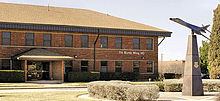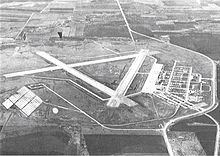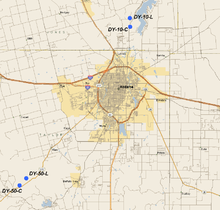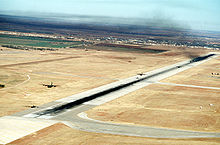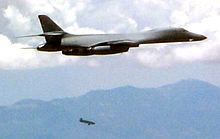- Dyess Air Force Base
-
Dyess Air Force Base Part of Air Combat Command (ACC) Located near: Abilene, Texas 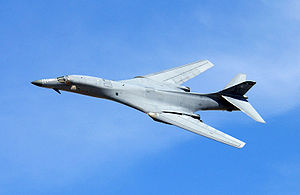
A B-1 Lancer performs a fly-by over Dyess AFBCoordinates 32°25′15″N 099°51′17″W / 32.42083°N 99.85472°W Built 1942 In use 1942-Present Controlled by  United States Air Force
United States Air ForceGarrison 
7th Bomb WingAirfield information IATA: DYS – ICAO: KDYS – FAA LID: DYS Summary Elevation AMSL 1,789 ft / 545 m Website Runways Direction Length Surface ft m 16/34 13,500 4,115 PEM 161/341 3,500 1,067 GRE 162/342 3,500 1,067 Asphalt Dyess Air Force Base (AFB) (IATA: DYS, ICAO: KDYS, FAA LID: DYS) is a United States Air Force base located approximately 7 miles (11 km) southwest of Abilene, Texas.
The host unit at Dyess is the 7th Bomb Wing (7 BW) assigned to the Air Combat Command Twelfth Air Force. The 7 BW is one of only two B-1B Lancer strategic bomber wings in the United States Air Force, the other being the 28th Bomb Wing at Ellsworth Air Force Base, South Dakota.
Dyess AFB was established in 1942 as Abilene Army Air Base (AAB). It is named in honor of Texas native and Bataan Death March survivor Lieutenant Colonel William Dyess. The 7th Bomb Wing is commanded by Colonel David B. Béen. The Vice Commander is Colonel Brian P. Donahoo and the Command Chief Master Sergeant is Chief Master Sergeant Douglas L. McIntyre.
Contents
Overview
Dyess AFB is a 6,409-acre (25.94 km2) base with over 13,000 military and civilian people. It is home to the 7th Bomb Wing, which consists of four groups. Two squadrons, the 9th and 28th Bomb Squadrons, fly the B-1B. In addition, the 28th Bomb Squadron is the Air Force schoolhouse for all B-1B aircrew members.
The base is located in the southwest corner of Abilene, TX and is about 200 miles (320 km) west of Dallas. The base employs more than 5,000 people, making it the single largest employer in the area. Dyess AFB has nearly 200 facilities on base, plus 988 units of family housing, and encompasses 6,117 acres (24.75 km2) of land. The base has a total economic impact of nearly $310 million yearly on the local community.
Units
The host unit at Dyess is the 7th Bomb Wing (7 BW) of the Air Combat Command (ACC), which was activated on October 1, 1993. The 7 BW performs combat training with the North American B-1B Lancer bomber and is the Air Force's premier operational B-1B unit with 36 aircraft.
The 7 BW consists of the following groups:
- 7th Operations Group (Tail Code: "DY")
- Responsible for executing global conventional bombing directed by proper command authority. It is the Air Force's largest B-1 operations group comprising 36 B-1s.
-
- 28th Bomb Squadron (B-1B) (Blue/White Chex tail stripe)
- 9th Bomb Squadron (B-1B) (Black tail stripe)
- 7th Operations Support Squadron
- 436th Training Squadron
- 7th Mission Support Group
- 7th Maintenance Group
- 7th Medical Group
The 317th Airlift Group (317 AG), an Air Mobility Command (AMC) tenant unit, performs Lockheed C-130 Hercules airlift operations with 33 C-130H1s. The unit is transitioning to new Lockheed Martin C-130J Super Hercules aircraft, with the first 2 of 28 delivered.
The 317th AG consists of the following squadrons:
- 39th Airlift Squadron "Trail Blazers" (C-130H) ("Dyess" Red tail stripe)
- 40th Airlift Squadron "Screaming Eagles" (C-130H/J) ("Dyess" Blue tail stripe)
- 317th Maintenance Squadron
- 317th Aircraft Maintenance Squadron
- 317th Maintenance Operations Squadron
- 317th Operations Support Squadron
Dyess AFB is also home to several tenant units, including Air Force Office of Special Investigations (AFOSI) Detachment 222.
History
The base is named after Lt Col William Edwin Dyess, a native of Albany, Texas, who was captured by the Japanese on Bataan in April 1942. Dyess escaped in April 1943 and fought with guerilla forces on Mindanao until evacuated by submarine in July 1943. During retraining in the United States, his P-38 Lightning caught fire in flight on December 23, 1943 near Burbank, CA. He refused to bail out over a populated area and died in the crash of his P-38 in a vacant lot.[1]
World War II
In 1942, the United States Army Air Forces built Tye Army Air Field, as it was popularly known, on the site of what is now known as Dyess AFB. On December 18, 1942, the field was opened and was initially named Abilene Army Air Base. The name was changed on April 8, 1943 to Abilene Army Airfield. The first host unit as Abilene AAB was the 474th Base HQ and Airbase Squadron, established on December 18, 1942. The airfield was initially assigned to Second Air Force and its mission was to be a flying training center for cadets.
Known groups which trained at the base during the war were:
- 77th Reconnaissance Group (April 6, 1943 – September 12, 1943)
- 69th Tactical Reconnaissance Group (September 10, 1943 – November 12, 1943)
- 408th Fighter-Bomber Group (November 10, 1943 – January 1944)
The 77th and 69th groups were units that trained reconnaissance personnel who later served overseas. The 408th was a new group which received A-24, A-26, P-40, and P-47 aircraft in October 1943 and began training. It was disbanded shortly after leaving Abilene on April 1, 1944.
On March 25, 1944, Republic P-47 Thunderbolt training for flight cadets was taken over by the 261st Army Air Force Base Unit. Training continued until April 1, 1946.
With the end of the war, the base was declared inactive on January 31, 1946. Although assigned to Continental Air Command, Abilene AAF was classified as an inactive sub-base of Fort Worth Army Airfield and was sold to the city of Abilene for $1. It was used as a training facility for the Texas Army National Guard for several years.
Cold War
Shortly after the Korean War broke out, the city of Abilene called for the need of a military installation. They believed the 1,500 acres (6 km²) of the former Tye AAF were the perfect site for a new base. The city's leaders went to The Pentagon with their request. The city showed their determination for a new base by raising almost $1 million dollars to purchase an additional 3,500 acres (14 km²) adjacent to the site. They were able to attract U.S. Senator Lyndon B. Johnson's (D-TX) attention, who had the power to persuade military officials to reactivate the base in Abilene. Finally, in July 1952, Congress approved the $32 million needed to construct an Air Force Base on the Tye AAF site. It was to be called Abilene Air Force Base and a little over three years after first starting construction, the base was opened on April 15, 1956.
Dyess' first active combat unit was the 341st Bombardment Wing, which activated on September 1, 1955. The 341st was part of the Strategic Air Command (SAC), flying the B-47 Stratojet, which it continued to operate until its deactivation on June 25, 1961.
On December 1, 1956, the name of the base was changed to "Dyess Air Force Base" in honor of the late Lt Col William E. Dyess, USAAF.
The 96th Bomb Wing moved to Dyess on September 8, 1957 and for a few years worked alongside the 341st. It included not just B-47 and B-52 nuclear bombers, but also the KC-97 and later on the KC-135 refueling aircraft. During the Cold War, the base was constantly on alert in case of nuclear attack. There were even signs in the base's movie theater that would instantly alert pilots in the scenario that the USSR would initiate a nuclear attack during a movie. These can still be seen today at the theater.
On 19 November 1959, the United States Army conducted groundbreaking ceremonies at Dyess AFB for the battalion headquarters of the 5th Missile Battalion, 517th Artillery of the U.S. Army Air Defense Command. Installed to defend the SAC bombers and Atlas F missile silos stationed at and around Dyess AFB, the two Nike Hercules sites were controlled by a "BIRDIE" system installed at Sweetwater Air Force Station. Site DY-10, located at Fort Phantom Hill 32°34′49″N 099°43′02″W / 32.58028°N 99.71722°W and site DY-50, located southwest of Abilene 32°16′17″N 099°57′32″W / 32.27139°N 99.95889°W, remained operational from 1960 until 1966.
Units stationed at Dyess Air Force Base while the 5/517th was operational included SAC's 819th Strategic Aerospace Division, the 96th BW, and the 578th Strategic Missile Squadron. Several of the 578th's Altas F Silos are located near the Nike sites. The Army Air Defense Command Post was located 37 miles west at Sweetwater AFS. Both of the sites were located near former Army posts. Camp Barkeley served as a World War II infantry division training center, while Fort Phantom Hill was a frontier outpost ans stop on the Butterfield stage route.
Since 1961, various models of C-130 Hercules aircraft have been stationed at Dyess AFB. The C-130s were originally assigned to the 64th Troop Carrier Wing (TCW) and from 1963 to 1972, the 516th Troop Carrier Wing was the host C-130 wing. In 1972, the 516 TCW was replaced with the 463d Tactical Airlift Wing (463 TAW). During the Vietnam War, TAC C-130 crews routinely rotated to forward based C-130 wings in the Pacific theater to support operations in Vietnam. In 1974, the 463 TAW was reassigned from Tactical Air Command TAC to Military Airlift Command (MAC) as part of a USAF-wide initiative to place both strategic and tactical airlift assets under MAC control.
From 1962 to 1965 Dyess Air Force Base had 13 SM-65 Atlas Missile sites Stationed around it. The Dyess sites were operated by the 578th Strategic Missile Squadron. After being decommissioned in 1965, the Atlas missiles were removed and all sites demilitarized.
In June 1985, the 96th received its first B-1B Lancer replacing the B-52 Stratofortress and in October 1986, assumed nuclear alert status. Since achieving IOC, Dyess has been recognized as the premier bomber training center and leads the fleet in maintaining the highest mission capability status. Shortly after, the Soviet Union fell and left many wondering the fate of the base. In 1991 the 463d Tactical Airlift Wing was simply designated the 463d Airlift Wing (463 AW). In October 1992, the parent commands of both wings changed. The 96 BW being reassigned to the newly established Air Combat Command (ACC), and the 463 AW being assigned to the new Air Mobility Command (AMC).
Modern era
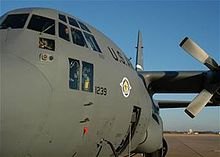 The No. 2 ship of the C-130 Avionic Modernization Program from Edwards Air Force Base, Calif., visited Dyess November 27. The program will update the avionics on more than 400 C-130s. Part of the program includes new navigation system, a heads-up display, an all-digital cockpit, and other technology advances.
The No. 2 ship of the C-130 Avionic Modernization Program from Edwards Air Force Base, Calif., visited Dyess November 27. The program will update the avionics on more than 400 C-130s. Part of the program includes new navigation system, a heads-up display, an all-digital cockpit, and other technology advances.
On October 1, 1993, the 96 BW and 463 AW were both deactivated and replaced by the 7th Wing, a former B-52 and KC-135 wing that had been located at the former Carswell AFB which was being realigned as NAS Fort Worth JRB/Carswell ARS as a result of Base Realignment and Closure (BRAC) action. The 7th Wing incorporated Dyess' B-1Bs and C-130s, the latter which transferred from Air Mobility Command to Air Combat Command.
Within its first year, the 7th Wing's diverse mission made it one of the most active units in the United States Air Force. The C-130s were deployed around the globe performing several airlift missions to Europe and the Persian Gulf. The crews and support people of the B-1s focused on enhancing the purpose of the Lancer in a post-Soviet 21st century.
In the 1997, Dyess' C-130s were transferred back to Air Mobility Command, and the 317th Airlift Group was created as the parent unit for Dyess' C-130 squadrons. At the same time, the 7th Wing was redesignated the 7th Bomb Wing. Despite this separation as units, both the 7th Bomb Wing and the 317th Airlift Group remained at Dyess.
One of the many unique features of Dyess is its extensive collection of static military aircraft on display. Collectively known as the "Linear Air Park," it contains 30 aircraft from World War II to the present, many of them formerly based at Dyess, and is located along the base's main road, Arnold Blvd. All but one plane has been flown before. Its most recent addition is the first operational B-1B Lancer, known as "The Star of Abilene," which made its final flight in 2003. It can be seen at the front gate to Dyess along with a recently retired C-130 Hercules located on the other side of the road (a tribute to the two main aircraft currently housed at Dyess).
Another unique feature of Dyess is its main source of energy. In January 2003, Dyess became the first Department of Defense installation in the United States to be powered exclusively from renewable wind energy. Today, most of the energy Dyess receives is from other sources of renewable energy, such as biomass, and is considered one of the "greenest" bases in the U.S. Air Force.
The remnants of Tye AAF can still be seen today. Parts of the old runway still exist as well as part of its parking area on the west side of Dyess.
Global War on Terrorism
The 7th Bomb Wing and 317th Airlift Group were called to duty once again shortly after September 11, 2001. Both played and continue to play vital roles in both Operation Enduring Freedom and Operation Iraqi Freedom. Many of the 7th BW's B-1s and support personnel deploy to Southwest Asia. From there the 7 BW provides close air support to troops in the field and precision strike missions with the B-1B Lancer. The 317th Airlift Group has been deployed continuously to Southwest Asia since December 2003 where the group provides airlift support to OIF, OEF and Combined Joint Task Force-Horn of Africa operations.
Previous names
- Established as: Abilene Army Air Base, 18 December 1942
- Prior to this date popularly known as Tye Field and Tye Army Air Base
- Abilene Army Airfield, 8 April 1943-13 January 1947
- Abilene Air Force Base, 1 October 1953
- Dyess Air Force Base, 1 December 1956–present
Major commands to which assigned
- Second Air Force, 13 October 1942
- Third Air Force, 2 March 1943
- Second Air Force, 15 November 1943
- Continental Air Forces, 16 April 1945-31 January 1946
- Strategic Air Command, 1 October 1953 to 31 May 1992
- Air Combat Command, 1 June 1992–present
Base operating units
- 474th HQ and Air Base Sq, 18 December 1942
- 261st AAF Base Unit, 1 April 1944
- 233d AAF Base Unit (Det), March 1946-c. January 1947
- 4021st Air Base Sq, 1 January 1955
- 341st Air Base Gp, 1 September 1955
- 819th Air Base Gp, 15 June 1956 (rdsgd 819th Combat Support Gp, 1 November 1958)
- 96th Combat Support Gp, 25 June 1961
- 7th Mission Support Group, 1 October 1993–present
Major units assigned
- 69th Tactical Reconnaissance Group, 10 September 1943-12 November 1943
- 77th Reconnaissance Group, 6 April-12 September 1943
- 408th Fighter-Bomber Group, 10 November 1943-January 1944
- 341st Bombardment Wing, 1 September 1955-25 June 1961
- 819th Air Division, 1 February 1956-2 July 1966
- 96th Bombardment Wing, 8 September 1957-1 October 1993
- 64th Troop Carrier Wing, 8 February 1961-1 January 1963
- 516th Troop Carrier Wing, 19 July 1962-1 June 1972
- 12th Air Division, 30 September 1976-15 July 1988
- 7th Bomb Wing, 1 October 1993–present
SM-65F Atlas Missile Sites
The 578th Strategic Missile Squadron operated twelve missile sites, of one missile at each site.
- 578-1 1.5 mi SE of Lake Fort Phantom Hill, TX 32°36′09″N 099°38′59″W / 32.6025°N 99.64972°W
- 578-2 1.5 mi S of Albany, TX 32°42′23″N 099°17′51″W / 32.70639°N 99.2975°W
- 578-3 2.5 mi SE of Clyde, TX 32°22′54″N 099°27′37″W / 32.38167°N 99.46028°W
- 578-4 9.6 mi SSW of Clyde, TX 32°16′25″N 099°32′28″W / 32.27361°N 99.54111°W
- 578-5 1.5 mi SE of Lake Coleman, TX 32°09′42″N 099°33′10″W / 32.16167°N 99.55278°W
- 578-6 2.7 mi E of Lawn, TX 32°08′25″N 099°42′12″W / 32.14028°N 99.70333°W
- 578-7 3.4 mi NE of Bradshaw, TX 32°07′51″N 099°51′18″W / 32.13083°N 99.855°W
- 578-8 4.9 mi ENE of Winters, TX 31°58′24″N 099°52′48″W / 31.97333°N 99.88°W
- 578-9 11.9 mi NW of Bradshaw, TX 32°12′37″N 100°03′03″W / 32.21028°N 100.05083°W
- 578-10 13.1 mi S of Trent, TX 32°18′05″N 100°09′11″W / 32.30139°N 100.15306°W
- 578-11 3.2 mi SSW of Anson, TX 32°42′40″N 099°54′34″W / 32.71111°N 99.90944°W
- 578-12 1.4 mi WNW of Corinth, TX 32°51′37″N 099°53′29″W / 32.86028°N 99.89139°W
See also
References
 This article incorporates public domain material from websites or documents of the Air Force Historical Research Agency.
This article incorporates public domain material from websites or documents of the Air Force Historical Research Agency.
 This article incorporates public domain material from the United States Government document "Dyess Air Force Base".
This article incorporates public domain material from the United States Government document "Dyess Air Force Base".- ^ "Comrades Pay Final Tribute to Lt. Col. William E. Dyess". Los Angeles Times. December 25, 1943.
- Maurer, Maurer. Air Force Combat Units Of World War II. Washington, DC: U.S. Government Printing Office 1961 (republished 1983, Office of Air Force History, ISBN 0-912799-02-1).
- Ravenstein, Charles A. Air Force Combat Wings Lineage and Honors Histories 1947–1977. Maxwell Air Force Base, Alabama: Office of Air Force History 1984. ISBN 0-912799-12-9.
- Mueller, Robert, Air Force Bases Volume I, Active Air Force Bases Within the United States of America on 17 September 1982, Office of Air Force History, 1989
External links
- Dyess Air Force Base at GlobalSecurity.org
- Profile from The Center for Land Use Interpretation
- FAA Airport Diagram (PDF), effective 20 October 2011
- Resources for this U.S. military airport:
- AirNav airport information for KDYS
- ASN accident history for DYS
- NOAA/NWS latest weather observations
- SkyVector aeronautical chart for KDYS
- Bob Bruce, Texas journalist who covered Dyess AFB for twelve years as military editor of the Abilene Reporter-News
 Air Combat Command (ACC)
Air Combat Command (ACC)Air Forces 
Center Bases Barksdale · Beale · Creech · Davis-Monthan · Dyess · Ellsworth · Holloman · Langley · Moody · Mountain Home · Nellis · Offutt · Seymour Johnson · Shaw · Tonopah · WhitemanWings BombCompositeFighterOther9th Reconnaissance · 98th Range · 99th Air Base · 505th Command and Control · 552nd Air Control · 633d Air BaseLinks to related articles Current military installations of Texas ArmyFortCampDepotIngleside • Red River
ArmyFortCampDepotIngleside • Red River
 NavyAir StationStationLanding Field
NavyAir StationStationLanding Field
Air
ForceBrooks City-Base • Dyess AFB • Goodfellow AFB • Lackland AFB • Laughlin AFB • Randolph AFB • Sheppard AFBAnnexCamp Bullis Training Annex • Kelly Field Annex • Lackland Training AnnexAir Reserve BaseNaval Air Station Fort Worth • Shoal Creek Bombing RangeEllington Field • Garland • Hensley Field • McMullen County Range
Coast
GuardCorpus Christi • HoustonStationFreeport • Galveston • Port Aransas • Port O'Connor • South Padre IslandMarine Safety UnitGalveston • Port ArthurLoran StationRaymondville Strategic Air Command (SAC)
Strategic Air Command (SAC)Bases Active
(MAJCOM)CONUSAltus (AETC) • Andersen (PACAF) • Andrews (AMC) • Barksdale (ACC) • Beale (ACC) • Bolling (AFDW) • Cannon (AFSOC) • Columbus (AETC) • Davis-Monthan (ACC) • Dyess (ACC) • Eielson (PACAF) • Ellsworth (ACC) • Eglin (AFMC) • F. E. Warren (AFSPC) • Fairchild (AMC) • Forbes (ANG) • Grand Forks (AMC) • Grissom (AFRC) • Homestead (AFRC) • Lincoln (ANG) • Little Rock (AETC) • MacDill (AMC) • Malmstrom (AFSPC) • March (AFRC) • McChord (AMC) • McConnell (AMC) • McGuire (AMC) • Minot (ACC) • Mountain Home (ACC) • Nellis (ACC) • Offutt (ACC) • Patrick (AFSPC) • Pease (ANG) • Rickenbacker (ANG) • Robins (AFMC) • Seymour Johnson (ACC) • Sheppard (AETC) • Selfridge (ANG) • Travis (AMC) • Vandenburg (AFSPC) • Westover (AFRC) • Whiteman (ACC) • Wright-Patterson (AFMC)
OverseasRAF Alconbury (USAFE) • Diego Garcia (RAF) • Kadena (PACAF) • RAF Fairford (USAFE) • RAF Lakenheath (USAFE) • RAF Mildenhall (USAFE) • Thule (AFSPC)
InactiveCONUSAmarillo • Bergstrom • Biggs • Bong (unbuilt) • Calumet Air Force Base • Carswell • Castle • Chennault • Clinton-Sherman • Dow • Eaker • Glasgow • Grand Island (AAF) • Griffiss • Hunter • K. I. Sawyer • Kearney • Kincheloe • Larson • Loring • Lowry • Mather • McCoy • Plattsburgh • Presque Isle • Ramey • Shilling • Stead • Turner • Walker • Wurtsmith
OverseasRAF Bassingbourn • Ben Guerir • Boulhaut • RAF Brize Norton • RAF Bruntingthorpe • RAF Burtonwood • RAF Chelveston • RAF Greenham Common • Goose Bay • Ernest Harmon • RAF High Wycombe • RAF Upper Heyford • Torrejón • RAF Manston • Morón • Nouasseur • RAF Scampton • RAF Sculthorpe • Sidi Slimane • RAF South Ruislip • U-Tapao • RAF Waddington • RAF Woodbridge • RAF Wyton • Zaragoza

Units Air ForcesSecond Air Force • Eighth Air Force • Fifteenth Air Force • Sixteenth Air Force • Twentieth Air ForceDivisions AirStrategic
AerospaceStrategic Missile13thReconnaissance6th Strategic Reconnaissance • 26th Strategic Reconnaissance • 55th Strategic Reconnaissance • 544th Aerospace Reconnaissance TechnicalAerospaceAFCONMAJCOM3918th • 3920th • 3960th • 3970th • 3973d • 4026th • 4038th • 4039th • 4042d • 4043d • 4047th • 4080th • 4081st • 4082d • 4083d • 4123d • 4126th • 4128th • 4130th • 4133d • 4134th • 4135th • 4136th • 4137th • 4138th • 4141st • 4157th • 4158th • 4170th • 4228th • 4238th • 4239th • 4241st • 4245th • 4252nd • 4258th • 4321stSupportUSAAF
Groups
*=Initial Assigned
Unit Upon SAC's
ActivationBombardmentFighter27th (6/47) • 55th (2/47)Reconnaissance91st Strategic Reconnaissance (1/47)Major
weapon
systemsBombersCommand
& ControlFightersMissilesReconnaissanceTankersTransportCommanders Emblems Strategic Air Command Emblem Gallery (On Wikimedia Commons) Tactical Air Command (TAC)
Tactical Air Command (TAC)Air Forces 
Air Divisions 20th (ADTAC) · 21st (ADTAC) · 23rd (ADTAC) · 24th (ADTAC) · 25th (ADTAC) · 26th (ADTAC) · 28th (ADTAC) · 831st · 832nd · 833rd · 834th · 835th · 836th · 837th · 838th · 839th · 840thNamed units Wings TFWOther1st SOW · 57th FWW · 63rd TAW · 64th TAW · 67th TRW · 75th TRW · 85th TFTW · 317th TAW · 363rd TRW · 405th TFTW · 461st TBW · 4505th ARWFormer
basesActive
(MAJCOM)Altus (AETC) · Brooks (AFMC) · Cannon (AFSOC) · Charleston (AMC) · Creech (ACC) · Davis-Monthan (ACC) · Dover (AMC) · Dyess (ACC) · Eglin (AFMC) · Hill (AMFC) · Holloman (ACC) · Hurlburt Field (AFSOC) · Langley (ACC) · Little Rock (AETC) · Luke (AETC) · MacDill (AMC) · McChord (AMC) · McConnell (AMC) · Moody (ACC) · Mountain Home (ACC) · Nellis (ACC) · Pope (AMC) Seymour Johnson (ACC) · Shaw (ACC) · Tonopah (ACC) · Tyndall (AETC) · Whiteman (ACC)InactiveInactive, but with a military presenceAircraft A-1 · A-7 · A-10 · A-37 · AC-47 · AC-119 · AC-130 · B-26 · B-57 · B-66 · C-7 · C-47 · C-82 · C-119 · C-123 · C-130 · E-3 · E-8 · EF-111 · EC-135 · F-4 · F-5 · F-15 · F-16 · F-47 · F-51 · F-80 · F-82 · F-84 · F-86 · F-89 · F-100 · F-101 · F-102 · F-104 · F-105 · F-106 · F-111 · F-117 · H-1 · H-5 · H-6 · H-19 · H-43 · H-60 · H-53 · KB-29 · KB-50 · KC-97 · O-1 · O-2 · OH-23 · OV-10 · P-40 · P-38 · R-4 · S-62 · T-6 · T-28 · T-29 · T-33 · T-38 USAAF Second Air Force in World War II
USAAF Second Air Force in World War IIAirfields Group Training Stations · Heavy Bombardment Training Stations · Replacement Training Stations · Tactical Airfields · Very Heavy Bomber Bases
Units Commands II Air Support Command · II Bomber Command · II Fighter Command · IV Air Support Command · XX Bomber Command · XXI Bomber Command · XXII Bomber CommandWings 5th Bombardment · 15th Bombardment Training · 16th Bombardment Operational Training · 17th Bombardment Training · 18th Replacement · 21st Bombardment · 46th Bombardment Operational Training · 58th Bombardment · 73d Bombardment · 315th Bombardment · 316th BombardmentGroups Bombardment 2d Bombardment · 6th Bombardment · 7th Bombardment · 9th Bombardment · 12th Bombardment · 16th Bombardment · 17th Bombardment · 19th Bombardment · 25th Bombardment · 29th Bombardment · 34th Bombardment · 39th Bombardment · 40th Bombardment · 42d Bombardment · 46th Bombardment · 47th Bombardment · 48th Bombardment · 85th Bombardment · 86th Bombardment · 86th Bombardment · 88th Bombardment · 94th Bombardment · 95th Bombardment · 96th Bombardment · 99th Bombardment · 100th Bombardment · 301st Bombardment · 302d Bombardment · 303d Bombardment · 304th Bombardment · 305th Bombardment · 306th Bombardment · 307th Bombardment · 308th Bombardment · 312th Bombardment · 330th Bombardment · 331st Bombardment · 333d Bombardment · 346th Bombardment · 351st Bombardment · 376th Bombardment · 379th Bombardment · 381st Bombardment · 382d Bombardment · 383d Bombardment · 384th Bombardment · 385th Bombardment · 388th Bombardment · 390th Bombardment · 393d Bombardment · 395th Bombardment · 396th Bombardment · 398th Bombardment · 399th Bombardment · 400th Bombardment · 401st Bombardment · 407th Bombardment · 415th Bombardment · 418th Bombardment · 444th Bombardment · 445th Bombardment · 446th Bombardment · 447th Bombardment · 448th Bombardment · 449th Bombardment · 450th Bombardment · 451st Bombardment · 452d Bombardment · 453d Bombardment · 454th Bombardment · 455th Bombardment · 456th Bombardment · 457th Bombardment · 458th Bombardment · 459th Bombardment · 460th Bombardment · 461st Bombardment · 462d Bombardment · 464th Bombardment · 467th Bombardment · 468th Bombardment · 469th Bombardment · 470th Bombardment · 471st Bombardment · 472d Bombardment · 484th Bombardment · 485th Bombardment · 486th Bombardment · 487th Bombardment · 488th Bombardment · 489th Bombardment · 490th Bombardment · 491st Bombardment · 493d Bombardment · 494th Bombardment · 497th Bombardment · 498th Bombardment · 499th Bombardment · 500th Bombardment · 501st Bombardment · 502d Bombardment · 504th Bombardment · 505th Bombardment · 509th CompositeFighter Reconnaissance 2d Reconnaissance · 3d Reconnaissance · 4th Reconnaissance · 5th Reconnaissance · 6th Reconnaissance · 7th Reconnaissance · 8th Reconnaissance · 71st Reconnaissance · 77th ReconnaissanceTroop Carrier 443d Troop CarrierUnited States Army Air Forces
First · Second · Third · Fourth · Fifth · Sixth · Seventh · Eighth · Ninth · Tenth · Eleventh · Twelfth · Thirteenth · Fourteenth · Fifteenth · Twentieth USAAF Third Air Force in World War II
USAAF Third Air Force in World War IIAirfields Group Training Stations · Replacement Training Stations · Tactical Airfields
Units Commands II Air Support Command · III Air Support Command · III Bomber Command · III Fighter Command · III Reconnaissance Command · III Tactical Air CommandDivisions III Tactical Air DivisionWings 8th Fighter Wing · 9th Fighter Wing · 40th Bombardment WingGroups Air Commando 2nd Air Commando · 3rd Air CommandoBombardment 3rd Bombardment · 12th Bombardment · 17th Bombardment · 21st Bombardment · 29th Bombardment · 30th Bombardment Group · 38th Bombardment · 44th Bombardment · 46th Bombardment · 47th Bombardment · 85th Bombardment · 88th Bombardment · 90th Bombardment · 91st Bombardment · 92nd Bombardment · 93rd Bombardment · 94th Bombardment · 95th Bombardment · 97th Bombardment · 98th Bombardment · 99th Bombardment · 100th Bombardment · 309th Bombardment · 310th Bombardment · 312th Bombardment · 319th Bombardment · 320th Bombardment · 321st Bombardment · 322d Bombardment · 323d Bombardment · 335th Bombardment · 336th Bombardment · 340th Bombardment · 344th Bombardment · 345th Bombardment · 386th Bombardment · 387th Bombardment · 391st Bombardment · 394th Bombardment · 396th Bombardment · 397th Bombardment · 409th Bombardment · 410th Bombardment · 411th Bombardment · 416th Bombardment · 417th Bombardment · 418th Bombardment · 451st Bombardment · 454th Bombardment · 463rd Bombardment · 483rd Bombardment · 488th BombardmentFighter 20th Fighter · 31st Fighter · 49th Fighter · 50th Fighter · 53rd Fighter · 54th Fighter · 56th Fighter · 59th Fighter · 79th Fighter · 80th Fighter · 81st Fighter · 84th Fighter · 85th Fighter · 311th Fighter · 332nd Fighter · 337th Fighter · 338th Fighter · 339th Fighter · 361st Fighter · 369th Fighter · 372nd Fighter · 404th Fighter · 405th Fighter · 408th Fighter · 414th Fighter · 506th FighterFighter-Bomber 27th Fighter-Bomber · 48th Fighter-Bomber · 86th Fighter-Bomber · 406th Fighter-Bomber · 407th Fighter-BomberReconnaissance 2d Reconnaissance · 9th Reconnaissance · 10th Reconnaissance · 26th Reconnaissance · 65th Reconnaissance · 67th Reconnaissance · 68th Reconnaissance · 69th Reconnaissance · 70th Reconnaissance · 75th Reconnaissance · 77th Reconnaissance · 423d Reconnaissance · 424th Reconnaissance · 426th ReconnaissanceUnited States Army Air Forces
First · Second · Third · Fourth · Fifth · Sixth · Seventh · Eighth · Ninth · Tenth · Eleventh · Twelfth · Thirteenth · Fourteenth · Fifteenth · TwentiethCategories:- 1942 establishments
- USAAF Second Air Force Group Training Stations
- USAAF Third Air Force Group Training Stations
- USAAF Second Air Force Replacement Training Stations
- Bases of the United States Air Force
- Strategic Air Command
- Facilities of the United States Air Force slated for realignment
- Abilene, Texas
- Buildings and structures in Taylor County, Texas
- Military facilities in Texas
- Space Shuttle landing sites
- Abilene metropolitan area
- Airfields of the United States Army Air Forces in Texas
Wikimedia Foundation. 2010.



